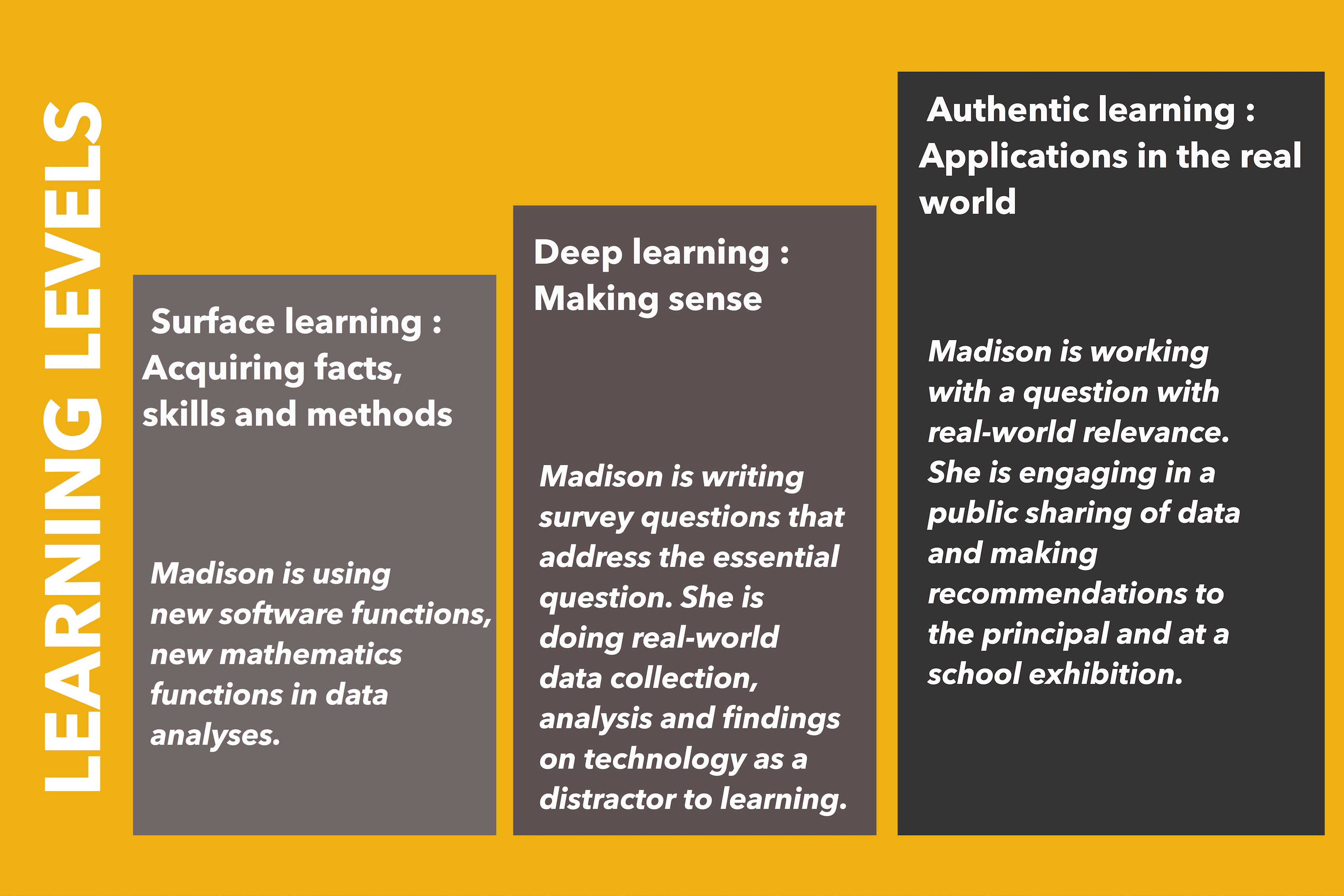![]() Remember to select the tab at the bottom of your screen to take notes.
Remember to select the tab at the bottom of your screen to take notes.
[back to Background Knowledge]

Empowered learners leverage technology to take an active role in choosing, achieving and demonstrating competency in their learning goals, informed by the learning sciences.
Opportunity: Madison and her eighth grade math classmates have become proficient with inquiry learning. She prides herself on her capacity to find great essential questions where she can be creative in learning math in the real world. Her teacher helps her class see the big picture by outlining the state content area learning standards and 21st Century standards they will address each semester, as well as the ISTE Standards they will address in each lesson or unit. During inquiry time, she decides which standards to work on by creating an inquiry project.
Context: Madison’s suburban school has a traditional class schedule (six-period bell schedule). However, all teachers are expected to use project-based learning. The school has a common inquiry learning model and has established learning standards and rubrics for all the content areas, plus the 21st Century Skills of online research, collaboration, critical thinking, communication and creativity, for which they use the ISTE Standards as a framework and guide.
Action: Madison’s class has learned the basics behind ratio, proportion and statistics. She is glad to be done with the skill building and to move on to the inquiry! Her team’s essential question for this semester is from her world geography class, “How does technology impact culture?” Using a human-centered design process established by their teacher, Madison and her team empathetically and strategically explore approaches to answering this question. Her team decides to investigate this question locally. As a first step, they check in with the principal. He says that teachers and students are indicating that technology distracts students from learning. They return to their design process strategy and decide to survey classmates, parents and community members about technology use and distractions.
The team creates and uploads survey questions into an online polling website. In their school and a nearby urban school, they will do a stratified sample of students, teachers, administrators and parents. To reach the community, they connect with the Chamber of Commerce to post an invitation to take the survey on their community social network. They do the same with an entrepreneurs’ network to get that perspective. Collecting data from various groups will enable Madison and her team to use ratio, proportion and statistics as they choose stratified samples of some groups; disaggregate data based on age, demographics and gender; and examine convenience samples of others. They will then create frequency statistics using software to generate charts and graphs of their results, all in pursuit of answers to their essential question. The final analysis will be shared in the social networks of all groups involved.
Indicators of ISTE Standard 1 – Empowered Learner:
1.a – Articulate and set personal learning goals, develop strategies leveraging technology to achieve them and reflect on the learning process itself to improve learning outcomes.
Madison’s essential question is a goal that reflects her interests. In math class, her team defined a project that enabled them to explore this question while demonstrating what they have learned about ratio, proportion and statistics. They used a digital survey system, conducted data analysis and charting with spreadsheets, and used calendars and collaborative documents in their work.
1.b – Build networks and customize their learning environments in ways that support the learning process.
Madison and her team network with potential survey respondent groups. They customize their learning environments by creating common team folders and documents for collaboration. They set up milestones and ticklers in their calendars for time management, and manage and tag resources digitally. They collect data through online surveys, inviting respondent groups to participate though social networks, and then analyze, visualize and report survey data digitally.
1.c – Use technology to seek feedback that informs and improves their practice, and to demonstrate their learning in a variety of ways.
Madison’s team is anxious to get feedback on its survey. They add a few questions at the end that provide them with respondents’ perspectives on the length, clarity of questions, etc. They demonstrate their learning through a report and slide presentation (facts and recommendations) on technology as a distractor for the principal and at the semester exhibition.
1.d – Understand the fundamental concepts of technology operations; demonstrate the ability to choose, use and troubleshoot current technologies; and can demonstrate ability to transfer their knowledge to explore emerging technologies.
Using technology in this project, Madison and team demonstrated their understanding of collaborative files and documents, and their proficiency in choosing appropriate software (digital survey systems, spreadsheets and word processing) for the task. They transferred their knowledge to emerging technologies by choosing and using cross-tabulation features on the spreadsheet.
[back to Background Knowledge]
[/student]

